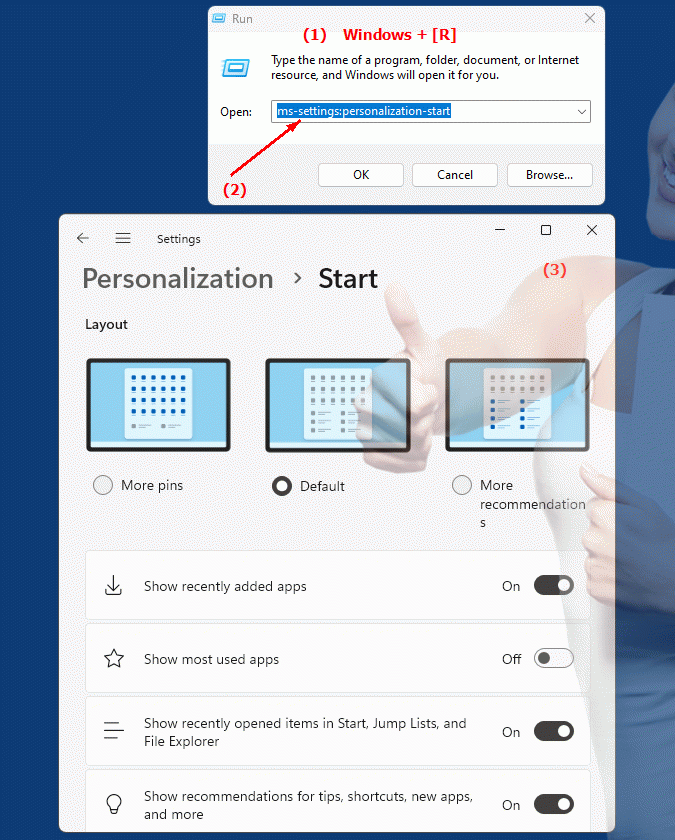The URL "ms-settings:personalization-start" opens the Start menu settings in Windows 10 und 11 , which allows users to customize the appearance and behavior of the Start menu.
This includes options like pinning apps, customizing tiles, layout options, and other Start menu-related settings. Here is a detailed description of the availability of this feature in different versions of Windows, along with the corresponding build numbers:
1. ms-settings:personalization-start
2. Availability under Windows
3. Other useful commands in the Windows settings
1. The Command ms-settings:personalization-start
1. Open the Run window using Windows R.2. All you need to do is use the command: ms-settings:personalization-start
(You can also use the command to create a desktop shortcut.)
3. You can confirm by pressing the OK button or [Enter].
(... see Image-1 Point 1 to 3)
You now have access to the settings described in your Windows 10, 11 or 12.
This leads to a solution to the following questions and problems.

1b. This leads to a solution to the following questions and problems.
How do I change the Start menu layout in Windows 10?Can I remove my lovingly chosen screen savers from the start menu?
How do I set or pin an app to the Start menu?
Which tiles can I set up in the Start menu?
Is it possible to use custom tiles in the Start menu?
How do I configure the display behavior of apps in the Start menu?
Are there differences in customizing Start menu settings between Windows 10 Home and Windows 10 Pro?
What are the recommended steps to customize the Start menu as you like?
How do I enable the automatic adjustment of Start menu settings feature on my computer?
Which apps can be hidden in the start menu?
2. Support in Windows 10, 11 and 12 starting with the build numbers.
Windows10
- Availability:
The Start menu customization feature was provided in Windows 10 from the initial release. Users can customize the Start menu layout, manage tiles, and change its appearance through these settings.
- Build number:
The "ms-settings:personalization-start" URL is available in Windows 10 starting with version 1607 (July 2016 Update). This version brought a number of customization options for the Start menu, including the ability to organize the tiles in the Start menu and customize the layout.
Windows11
- Availability:
In Windows 11, the Start menu has received a major redesign, and the Start menu customization feature remains available, but with a new interface and additional options. Windows 11 offers a modernized and simplified version of the Start menu that includes more customization and a new design.
- Build number:
The "ms-settings:personalization-start" URL is available in Windows 11 starting with version 21H2 (Initial Release). This version, released on October 5, 2021, offers the new customization options and updated Start menu design introduced in Windows 11.
Windows12
- Availability:
In Windows 12, the Start menu customization feature is expected to continue to be supported and may come with additional features and improvements to align with the latest design trends and user needs. Windows 12 is expected to offer more customization options and an updated design.
- Build number:
The exact build number for the feature's introduction in Windows 12 will be provided after the first versions of the operating system are released. However, the feature is expected to be available starting from the early builds of Windows 12 and will include the latest Start menu customization features.
Summary
The "ms-settings:personalization-start" URL is available in Windows 10 starting with version 1607 (build 14393) and remains available in Windows 11 starting with version 21H2, as well as in Windows 12. This URL allows users to directly access the settings for customizing the Start menu, including managing tiles and layout options. The exact build number for Windows 12 will be provided after the initial releases, but the feature is expected to be included in the early versions of the new operating system.
